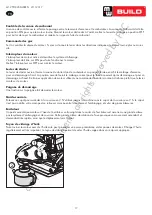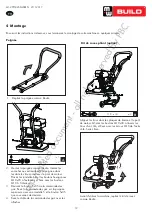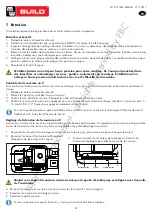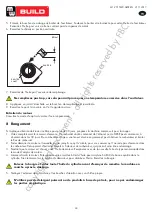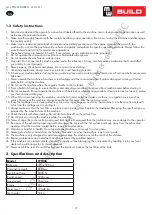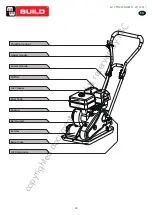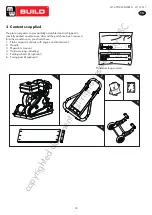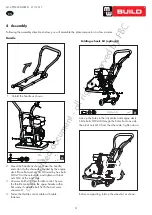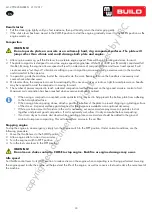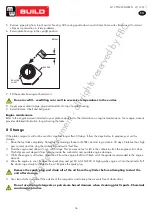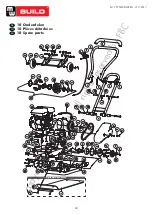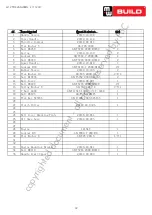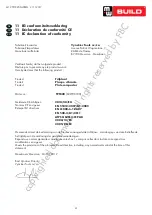
29
M1.2.TPT820.NLFREN 21112017
EN
Fuel valve control
The fuel valve opens and closes the passage between the fuel tank and the carburetor. The fuel valve lever must be in the ON
position for the engine to run. When the engine is not in use, leave the fuel valve lever in the OFF position to prevent carburetor
flooding and to reduce the possibility of fuel leakage.
Throttle control
The throttle lever controls engine speed. Moving the throttle lever in the directions shown makes the engine run faster or slower.
Engine switch
The engine switch enables and disables the ignition system.
The engine switch must be in the ON position for the engine to run.
Turning the engine switch to the OFF position stops the engine.
Choke lever
The choke lever opens and closes the choke valve in the carburetor. The closed position enriches the fuel mixture for starting a
cold engine. The open position provides the correct fuel mixture for operation after starting, and for restarting a warm engine.
Some engine applications use a remotely-mounted choke control rather than the engine-mounted choke lever.
Recoil starter grip
Pulling the starter grip operates the recoil starter to crank the engine.
Belt guard
Remove this guard to gain access to the V-belt. Never run the compactor without the V-belt guard. If the V-belt guard is not
installed, the possibility exists that your hand may get caught between the V-belt and clutch, thus causing serious injury and
bodily harm.
Exciter
An eccentric weight mounted on the exciter shaft contained within exciter housing is driven at high speed by a clutch and belt
drive system. This high speed shaft revolution causes the rapid lifting and downward ramming motion of the machine as well as
imparting a forward motion.
Oil drain hose
Running the engine with dirty oil can cause premature engine wear and failure. Changing oil regularly is extremely important.
The flexible oil drain hose is equipped to drain oil into appropriate receptacle.
Compactor Operation
Adding fuel
Fill the fuel tank as instructed in the separate
Engine Manual
packed with the Plate Compactor.
1. Move the fuel valve lever to the ON position.
2. To start a cold engine, move the choke to the
CLOSE position.
To restart a warm engine, leave the choke lever
in the OPEN position.
3. Move the throttle lever away from the SLOW
position, about 1/3 of the way toward the FAST
position.
4. Turn the engine switch to the ON position.
5. Operate the starter.
If the choke lever has been moved to the CLOSE
position to start the engine, gradually move it to
the open position as the engine warms up.
Operating
Starting engine
The open position provides the correct fuel mixture
for operation after starting, and for restarting a
warm engine. Some engine applications use a
remotely-mounted choke control rather than the
engine-mounted choke lever.
Recoil Starter Grip
Pulling the starter grip operates the recoil starter
to crank the engine.
More detailed description of the engine operation and
all related precautions and procedures can be found
in the
Engine Manual
packed separately with the unit.
9
Vibratory Plate Compactor
Pull the starter grip lightly until you feel resistance,
then pull briskly, return the starter grip gently.
Recoil Starter
Oil Drain Hose
Running the engine with dirty oil can cause
premature engine wear and failure. Changing oil
regularly is extremely important. The
flexible
oil
drain hose is equipped to drain oil into appropriate
receptacle.
After engine warms up, pull throttle lever to
accelerate engine speed. Plate will begin
vibrating and move forward.
The plate compactor is designed to run at an
engine speed (engine take off shaft) of 3600
rpm (Normally considered full throttle). Running
the engine at lower rpm’s will result in a decrease
of compaction force and lower travel speed. It
will create excessive “out-of-synch” vibrations
resulting in poor compaction, maneuverability,
excessive wear to the machine, and discomfort
to the operator.
In operation, guide the machine, but let the
compactor do the work. Bearing down on the
handle is unnecessary and causes shock
absorber wear.
1.
2.
3.
Exciter
An eccentric weight mounted on the exciter shaft
contained within exciter housing is driven at high
speed by a clutch and belt drive system. This high
speed shaft revolution causes the rapid lifting and
downward ramming motion of the machine as well
as imparting a forward motion.
Do not operate plate on concrete or
on extremely hard, dry, compacted
surfaces. The plate will jump rather
than vibrate and could damage both
plate and engine.
1
2
copyrighted
document
- all
rights
reserved
by
FBC



